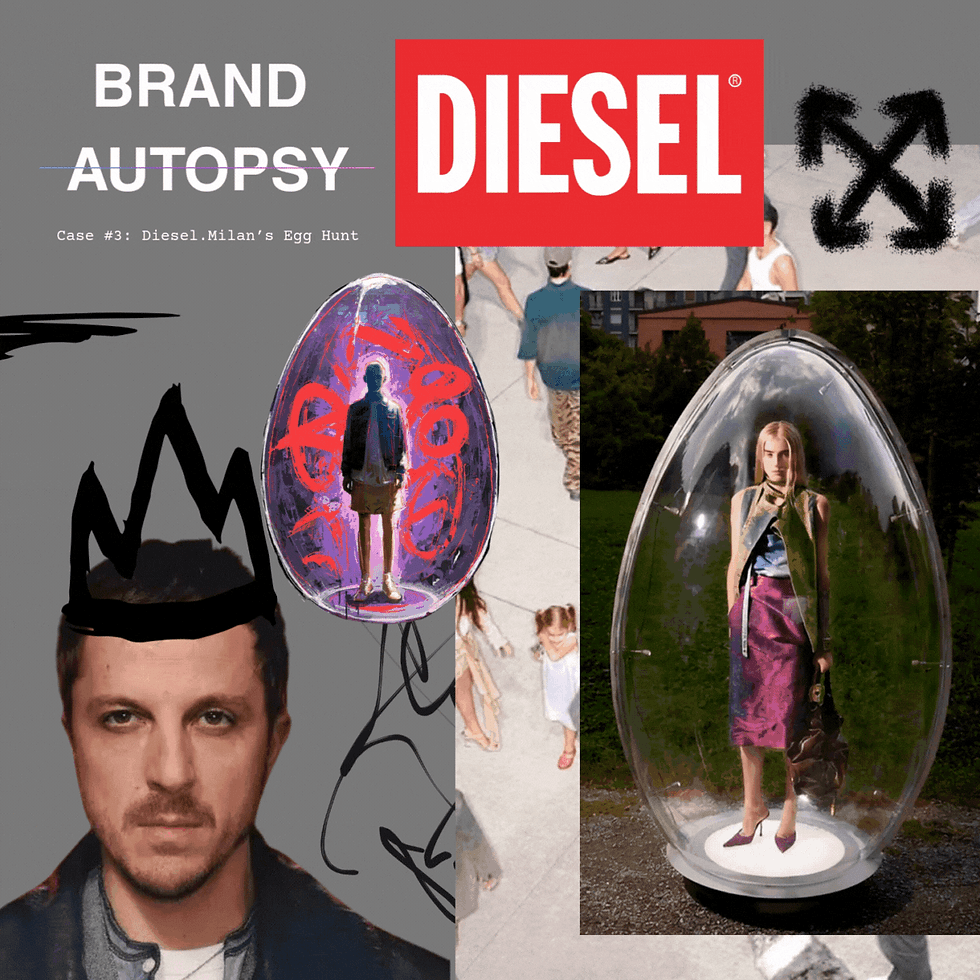Brand Autopsy #3:Diesel Turns Milan into a Citywide Fashion Game
- Olena Zaitseva

- Sep 24
- 5 min read

Overnight in Milan, transparent egg-shaped capsules appeared in city squares and side streets. Each capsule revealed a look from Diesel’s new collection, transforming the entire city into an open-air fashion show and a real-time treasure hunt.
Instead of a classic runway presentation, Diesel created a large-scale example of experiential fashion marketing, inviting anyone to join the game and discover the collection themselves. The stunt immediately became one of the most talked-about moments of Milan Fashion Week, reported by leading industry outlets including Business of Fashion and WWD.
At the heart of this strategy is Glenn Martens, Diesel’s creative director since 2020, celebrated for re-energising the denim powerhouse and now preparing his womenswear debut at Maison Margiela. Martens has often described fashion as a balance between what you reveal and what you choose to hide (Crash Magazine interview), a philosophy that perfectly frames Diesel’s egg hunt across Milan.

Glenn Martens: the Mind Behind Diesel’s Egg Hunt
Belgian designer Glenn Martens has built his reputation on turning brand heritage into contemporary spectacle.Before joining Diesel in 2020, he graduated from the prestigious Royal Academy of Fine Arts in Antwerp and led the conceptual label Y/Project, where his ability to twist classic garments into unexpected forms first caught the industry’s attention (Business of Fashion profile).
Martens often describes his approach to fashion as a conversation between exposure and restraint. In an interview with Contributor Magazine, he explained: “It’s about what you like to reveal and what you choose to hide. For me, it’s more provocative to use nipple piercings on a polo shirt than to show a pair of tits under a transparent top.” (Contributor Magazine).This philosophy of controlled revelation helps explain why Diesel’s Milan installation relied on transparent capsules—objects that display and protect at the same time.
When he took the helm at Diesel, Martens inherited what he once called a brand experiencing a “classic midlife crisis”: “I had to remind everybody that they were sitting on a gold mine,” he told Hypebeast.His strategy was to reclaim Diesel’s DNA—denim expertise, industrial treatments, and rebellious attitude—and push it into the present.
Martens’ creative calendar is even more ambitious now. Alongside Diesel’s revival, he is preparing his first womenswear collection for Maison Margiela, promising a debut that will be, in his own words, “quite loud” (Vogue interview).This dual role highlights his ability to work across very different brand codes while maintaining a single creative language built on experiential fashion marketing and theatrical storytelling.
Dissecting the Milan Egg-Capsule Installation
Diesel’s egg hunt across Milan was more than a publicity stunt. It was a fully fledged exercise in experiential fashion marketing, designed to rewrite the rules of a fashion-week reveal.
1. The City as Runway
Instead of one exclusive venue, the entire city became the stage. Transparent egg-shaped capsules were placed in piazzas, side streets and busy intersections. Each capsule displayed a look from the new collection, visible to anyone who happened to pass. This move broke the traditional hierarchy of fashion shows and gave the public the kind of front-row access normally reserved for editors and buyers.Coverage from WWD and Business of Fashion confirmed that the stunt quickly became one of the most photographed and shared moments of Milan Fashion Week 2025.
2. Gamification Creates Viral Reach
By turning the collection reveal into a citywide treasure hunt, Diesel built a self-propelling marketing machine. People who found a capsule were eager to share their discovery across social platforms, creating organic buzz without relying on paid advertising. The game itself became the content.
3. Controlled Transparency
Martens’ own words about fashion being a balance of “what you like to reveal and what you choose to hide” (Contributor Magazine) resonate here. The capsules revealed Diesel’s designs but kept them physically untouchable, creating tension between visibility and exclusivity—a hallmark of experiential fashion marketing.
4. Aligning With Diesel’s DNA
Diesel’s heritage lies in industrial denim and fearless street energy. Giant glass eggs scattered through Milan echoed this DNA: bold, urban, slightly irreverent. As Martens told Hypebeast, his mission was to remind people the brand is “sitting on a gold mine.” The egg hunt demonstrated that Diesel can still surprise, provoke and dominate headlines.
5. Risks Worth Taking
This type of large-scale urban installation comes with real risks—logistical issues, weather, vandalism and the possibility that interest fades quickly once the hunt ends. Yet these risks underscore Diesel’s willingness to gamble in order to capture global attention.
Strategic Lessons for Brands and Marketers
Diesel’s Milan installation is more than a headline-grabbing spectacle. It serves as a playbook for experiential fashion marketing and offers clear takeaways for any brand that wants to merge creativity with measurable impact.
1. Design an Iconic Object
Diesel chose a single, instantly recognisable shape: the giant transparent egg. From a distance or on a phone screen it reads in a fraction of a second.Lesson: Pick one visual element strong enough to become shorthand for the entire campaign. A shape that works at billboard scale and as a 50-pixel thumbnail will travel effortlessly across social platforms.
2. Turn the Audience into Participants
By transforming Milan into a citywide treasure hunt, Diesel converted passive spectators into active players. Each person who discovered a capsule effectively became a co-creator of the campaign, posting images and spreading the story for free.Lesson: When the audience takes part in the reveal, you gain both engagement and organic reach.
3. Balance Access and Exclusivity
The capsules allowed anyone to view the collection, yet their sealed glass kept the garments untouchable. This mirrors Glenn Martens’ philosophy of “what you like to reveal and what you choose to hide” (Contributor Magazine).Lesson: In experiential fashion marketing, tension between openness and distance creates desire and drives conversation.
4. Amplify Core Brand DNA
Martens reminded the industry that Diesel is “sitting on a gold mine” of bold industrial style (Hypebeast interview). The egg hunt expressed that heritage in a contemporary form: street-ready, fearless and slightly irreverent.Lesson: Make sure every stunt or activation is unmistakably tied to the brand’s authentic identity.
5. Plan the Second Beat
An event of this scale burns bright and fast. To extend impact, brands need a follow-up: exclusive product drops, behind-the-scenes content or augmented-reality versions of the installation.Lesson: For experiential fashion marketing to convert attention into long-term value, prepare the next chapter before launch day.
Diesel’s egg hunt is a reminder that experiential fashion marketing is not just decoration, it is strategy. Glenn Martens transformed a product launch into a living narrative, turning the streets of Milan into both stage and media channel. The result: a campaign that people did not just watch, but played.









Comments